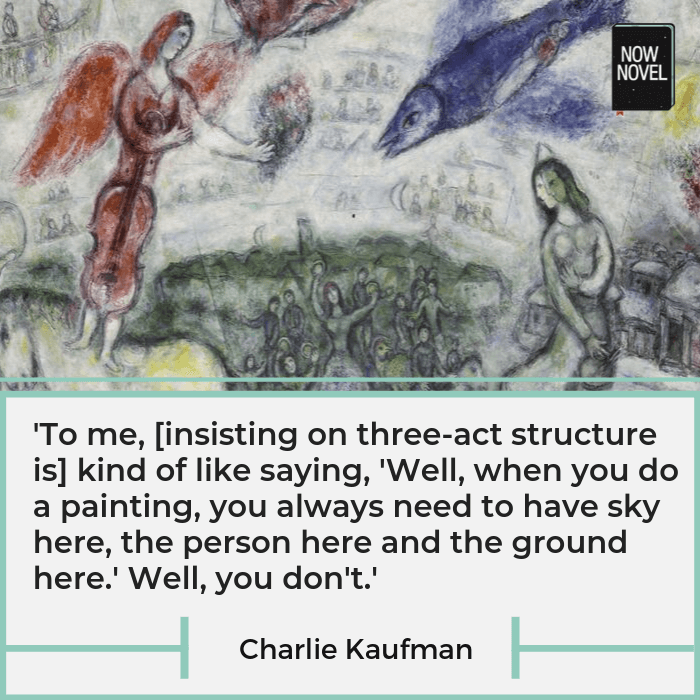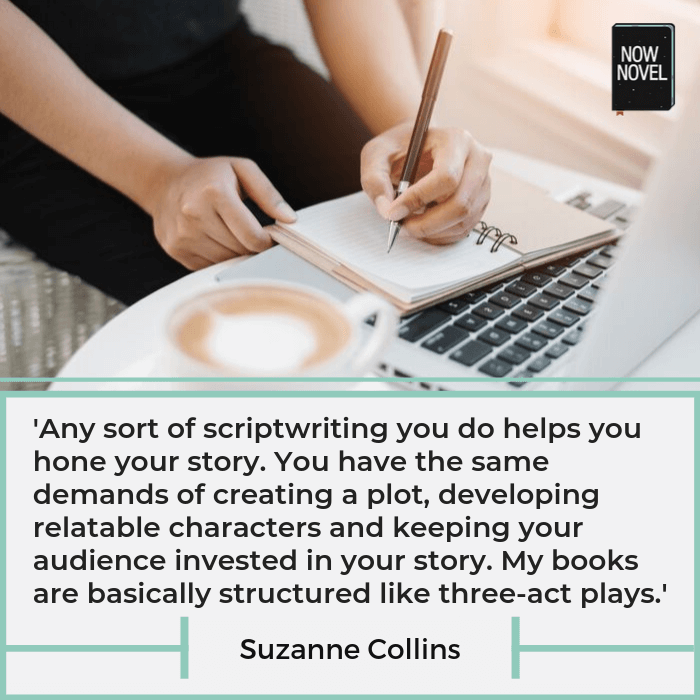There are many different ways to plan and structure a story. 'Three-act structure' is one that some writers swear by and others shun. Learn what three-act structure is, why it's controversial, and how to make it work for you if you use it to plan and write your story:
Contents
What is three-act structure?
Pros and cons of three-act structure: The debate
5 tips for using three-act structure well
What is three-act structure?
Three-act structure refers to the narrative structure of a story; how it can be divided into three main parts or 'acts' with each serving a specific narrative purpose.
The term comes from the theater, where the grouping of scenes into acts allows for intervals.
The idea of three-act structure is often attributed to Aristotle, yet in his Poetics, he never mentioned anything about a story having 'three acts', only saying that a story should have a 'beginning, middle and end.'
Even so, many have taken up the idea of three-act structure as a useful concept for organising the beginning, middle and end. What each should (ideally) cover in terms of plot development.
To break down the classic concept of three-act structure, it divides a story into three parts consisting of:
I. The setup
This section of a story sets up the conflict, event or scenario which gives rise to the action.
This is where we find the 'inciting event', an incident that gives characters reasons to quest, desire, resist, want. It shares the initial causes driving action.
Example: The revelation that an orphan must be kept safe from a dangerous wizard, introduced as 'He Who Must Not Be Named', in the first book of J.K. Rowling's Harry Potter series.
II. The confrontation
Following from the setup that contains the story's exposition (the key background to what happens next), the second act typically reveals obstacles and complications characters encounter en route to fulfilling their goals, wants or needs.
This part of the story also typically introduces secondary characters who further complicate the story and add subplots and bring related secondary arcs.
Example: The various friends Harry makes at his school and their individual confrontations, obstacles and desires.
III. The resolution
The resolution. The third act leads to the climax or denoument (the 'untying' of the story's knotty complications so far).
This is typically where primary characters overcome obstacles (in the case of heroic victory) or the protagonist experiences their ultimate undoing (in the case of a tragic story). The story's key mysteries or unknowns are typically resolved during this phase.
Example: The showdown with a secondary villain that has been haunting the walls of Harry's school at the end of Harry Potter and the Chamber of Secrets
2. Pros and cons of using three-act structure: the debate
Writers feel strongly both in favour of writing with three-act structure and against the idea:
Pros of storytelling using three-act structure
Some pros of using three-act structure:
A. Keeping narrative focus: A three-part underlying structure may help you to find a focus for each part of your story, such as how the start of your story sets up key conflicts or challenges. Or how the middle develops this setup. Or how the end 'unties' the narrative knots you've invented along the way.
B. Ensuring cohesion: Three-act structure encourages a more cohesive story, as you're thinking about an initial scenario, how it's developed and complicated, and how it resolves. There's a running thread built into the underlying structure.
C. Shaping and balancing each segment of your story: Some stories feel like they take forever to get to their inciting incidents. Others suffer from what we call the 'sagging middle'.
Dividing your story into three acts could help you ensure each part develops at a good pace without becoming overlong. Each act may have a clearer direction and purpose.
Cons of storytelling using three-act structure
Despite these useful elements of planning a three-act structure for your story, three-act structure has naysayers. Criticisms of it include that it:
A. Imposes arbitrary structure on a story, rather than organising a story around a more organic understanding of cause and effect (this sums up TV writer James Bonnet's views here).
B. Transposes the necessities of theater (intermissions, allowing for backdrop changes) to other media like films and novels unnecessarily. Meanwhile, these media allow more fluid or experimental storytelling (this is John Truby's argument against using three-act structure here).
C. Puts the idea of following a linear or set 'structure' above the idea that a story solves a problem according to its own, individual creative needs (another of James Bonnet's issues with three-act structure, which he voices here)
The last issue (imposing structure) was part of our decision to rework Now Novel's story outlining tools entirely in 2018. We listened to members' feedback that they found the linear approach too rigid, and reworked the outlining steps to allow greater creative freedom.]

3. 5 tips for using three-act structure well
Criticisms aside, here are 5 tips to use three-act structure well:
I. Use three-act structure as a loose guide
As with any framework, three-act structure is a useful concept. Remember, though, to give yourself the freedom to depart from a rigid 'Setup - confrontation - resolution' structure. Especially if your story would have more intrigue, suspense or tension thanks to this departure.
For example, some great novels begin by sharing part of the confrontation within the setup.
Donna Tartt does this in The Secret History, when the reader learns of a key character's murder in the opening pages. Setup and confrontation are rolled into one here. Yet with enough mystery and narrative suspense (because of the questions 'Who did it?' and 'Why?') to keep the story moving.
II. Give your setup an intriguing, early hook
The hook, the part of an opening that lures your reader in, needs to be interesting.
Don't spend 20 pages of the setup telling your reader what your main character had for breakfast. This doesn't setup the confrontation (unless your character's breakfast choice is a source of conflict or plot development).
Use your setup to create unanswered questions involving the '5 W's' of story: Who? What? Why? Where? and When? The Secret History makes the reader ask 'Who killed Bunny Corcoran and why?' as well as 'Where did it happen and when?' and 'What will the consequences be?'
III. Keep your setup relevant to later events
Besides being interesting (by creating curiosity through partially-revealed unknowns), the setup needs to be relevant.
How does it connect to what will occur in Act 2? What links are there between characters, themes, places, events, ideas?
For example, the first act in Tolkien's famous fantasy cycle The Lord of the Rings establishes the ring's corrupting power and the necessity of its destruction.
The second act shows the reader examples of the ring's corrupting influence, such as when Boromir (one of Frodo's quest-mates) tries to persuade him to let him carry the ring, and the man's insistence turns threatening and aggressive.

IV. Connect subplots in your confrontation to main arcs
A story's focus wanders when middle chapters pursue new, unconnected trajectories. In three-act structure, the middle act develops, rather than starting afresh on a new track.
A core subplot may illustrate a different side of a character's nature key to understanding their further choices and actions. Or it may explore another aspect of a theme already explored.
For example, in Jane Austen's classic novel Pride and Prejudice, the confrontation is established when Elizabeth Bennett takes a dislike to Mr Darcy when she overhears insulting comments he makes about her at a dance.
After Elizabeth's sister Lydia elopes with a man who has no intention of marrying her (a scandal in Austen's time), it is Mr Darcy who intervenes, in her 'honour', however. This subplot - Mr Darcy's looking out for Lizzie's sister - gives Lizzie a reason to see Darcy in kinder terms. This in turn enables the main romantic arc to build.
The 'runaway sister' subplot is thus linked to the main plot. It's connected to the key confrontation (the main story arc's romantic tension, between Lizzie and Darcy). This connection creates satisfying cohesion (events fit together).
V. Keep rising and falling action intriguing
Have you ever read a book that petered out somewhere near the middle? Or the end wrapped up the story a little too neatly, in a predictable, shiny bow?
One of the risks of using a template-like concept like three-act structure is you could treat each act as having one, fixed function. For example, the denouement only wraps up or resolves the story's main problems.
In truth, even the climax can add new complications. For example, when Frodo and his friends return to the Shire after completing their main quest in The Lord of the Rings, there's a major power struggle afoot back home.
This reminds us that a good story isn't told simply in obeying a pre-existing template or rule.
Great stories are equally told by departing from expectations. By surprising the reader in the first, second or third act. If you use three-act structure, make sure to allow yourself to vary and develop your story's three parts any way you like, if it serves the story's intrigue, surprise and magic.
Need help improving the structure of your story? Get feedback on your finished manuscript from a professional editor, or work one-on-one with a writing coach if you're still developing your story.









